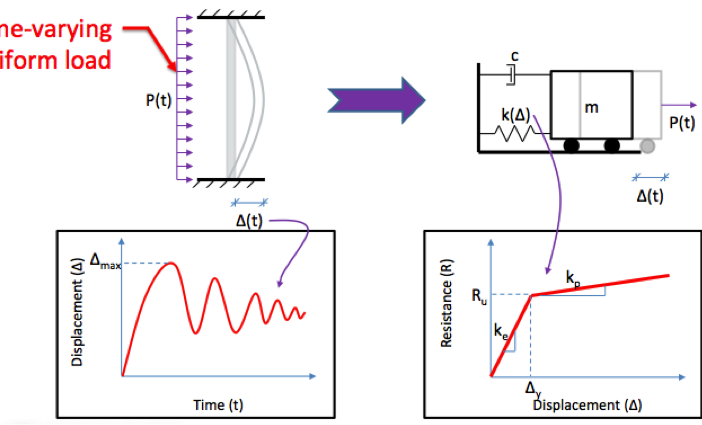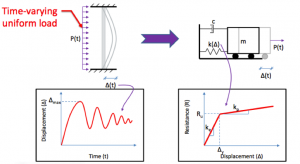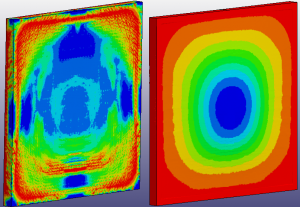
When looking at structural design or analysis for response to blast loading, there are two basic analytic approaches that are commonly implemented: Dynamic Single-Degree-of-Freedom Analysis and Dynamic Finite Element Analysis.
Dynamic Analysis
Dynamic analysis is used when dealing with blast loads. This type of analysis assumes that the load is applied instantaneously (or nearly so), generally with a finite duration (in the range of milliseconds). Strength Increase Factors (SIFs) and Dynamic Increase Factors (DIFs) are applied to the static material values to account for:
- Average expected strength, as opposed to published minimum values (SIF)
- Strain rate strength enhancement, which can be relatively high, for example, for some grades of steel (DIF)
Dynamic analysis typically yields a displacement response that reaches a maximum value, then decreases with time (as opposed to a static analysis that reaches a steady state solution). The response may oscillate multiple times depending on the blast load and loaded component characteristics.
Dynamic Single-Degree-of-Freedom (SDOF) Analysis
SDOF analysis is a simplified analytic technique, which is the most common dynamic approach used when investigating blast resistance. In this approach, a structural component is represented as an SDOF model and is assigned equivalent properties of a spring-mass system (e.g., mass, stiffness, and resistance) to approximate component bending response. This simplified system is typically used to calculate the displacement of the center point of the element (e.g., beam, column, wall). The figure below shows graphically how the system is being simplified.
The results of the SDOF analysis are generally defined in terms of support rotation and ductility. The calculated maximum rotation and ductility are then compared to pre-determined response limits to translate the analytic results to damage levels (e.g., superficial, moderate, heavy, and hazardous) and then to overall Levels of Protection (e.g., Low, Medium, and High). There are numerous industry reference documents that provide this correlation of analytic results to damage levels. Some widely-used documents include:
- US Army Corps of Engineers Protective Design Center’s PDC TR-06-08
- ASCE 59-11 – Blast Protection of Buildings
- ASCE Design of Blast-Resistant Buildings in Petrochemical Buildings
- General Services Administration Facility Security Requirements for Explosive Devices Applicable to Facility Security Levels III and IV GSA’s Interpretation of the Interagency Security Committee (ISC) Physical Security Criteria (FOUO)
SDOF analysis allows for rapid analysis of individual building components, which means that it is well-suited to blast vulnerability assessments of existing buildings and for use during initial and final design phases. It allows multiple variations of calculations to be run in order to converge on a cost-effective and constructible solution that meets the applicable protective design requirements.
Finite Element Analysis
FEA is another approach to blast resistant design. Dynamic FEA is a high fidelity technique in which the structural component or system is broken down into a large (but finite) number of discrete elements. The analysis entails simultaneous equations being solved at different time steps, thereby allowing various parameters (e.g., deformation, stress) along the component (as opposed to a single deflection value in an SDOF analysis) to be determined and visualized throughout the response cycle.
The figure below shows an example of FEA output.
FEA is generally not called for when analyzing simple building elements/systems for far-field blast loads (i.e., blasts that are far enough away to develop uniform loading over the face of the element/system being analyzed). FEA can be a useful tool when looking at close-in explosions and/or complex configurations that act as multi-degree-of-freedom systems. If FEA analysis is used, it is most appropriate once the design is well-developed, and not expected to vary significantly as the design process goes forward. This is because the FEA approach is often time-consuming (and, in following, costly). FEA assumes a far more detailed understanding of how a specific building is constructed than is commonly available for blast assessments or during the schematic and early design development phases of a project.


